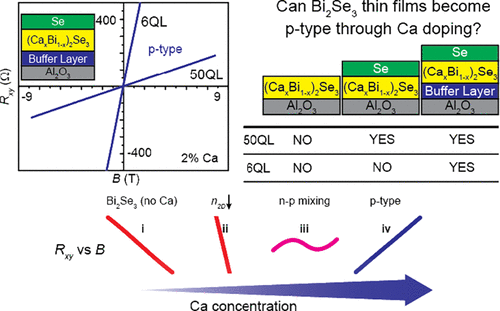当前位置:
X-MOL 学术
›
Nano Lett.
›
论文详情
Our official English website, www.x-mol.net, welcomes your
feedback! (Note: you will need to create a separate account there.)
Solution to the Hole-Doping Problem and Tunable Quantum Hall Effect in Bi2Se3 Thin Films
Nano Letters ( IF 9.6 ) Pub Date : 2018-01-17 00:00:00 , DOI: 10.1021/acs.nanolett.7b04033 Jisoo Moon 1 , Nikesh Koirala 1 , Maryam Salehi 1 , Wenhan Zhang 1 , Weida Wu 1 , Seongshik Oh 1
Nano Letters ( IF 9.6 ) Pub Date : 2018-01-17 00:00:00 , DOI: 10.1021/acs.nanolett.7b04033 Jisoo Moon 1 , Nikesh Koirala 1 , Maryam Salehi 1 , Wenhan Zhang 1 , Weida Wu 1 , Seongshik Oh 1
Affiliation

|
Bi2Se3, one of the most widely studied topological insulators (TIs), is naturally electron-doped due to n-type native defects. However, many years of efforts to achieve p-type Bi2Se3 thin films have failed so far. Here, we provide a solution to this long-standing problem, showing that the main culprit has been the high density of interfacial defects. By suppressing these defects through an interfacial engineering scheme, we have successfully implemented p-type Bi2Se3 thin films down to the thinnest topological regime. On this platform, we present the first tunable quantum Hall effect (QHE) study in Bi2Se3 thin films and reveal not only significantly asymmetric QHE signatures across the Dirac point but also the presence of competing anomalous states near the zeroth Landau level. The availability of doping tunable Bi2Se3 thin films will now make it possible to implement various topological quantum devices, previously inaccessible.
中文翻译:

Bi 2 Se 3薄膜中的空穴掺杂问题和可调谐量子霍耳效应的解决方案
Bi 2 Se 3是研究最广泛的拓扑绝缘体(TIs)之一,由于n型天然缺陷而被自然电子掺杂。但是,迄今为止,为实现p型Bi 2 Se 3薄膜而进行的多年努力都失败了。在这里,我们为这个长期存在的问题提供了解决方案,表明主要的罪魁祸首是界面缺陷的高密度。通过界面工程方案抑制这些缺陷,我们已经成功地将p型Bi 2 Se 3薄膜实施到了最薄的拓扑结构。在这个平台上,我们展示了Bi 2 Se 3中的第一个可调谐量子霍尔效应(QHE)研究。薄膜,不仅在整个狄拉克点上显示出明显的非对称QHE特征,而且在第0兰道能级附近也存在竞争的异常状态。掺杂可调谐Bi 2 Se 3薄膜的可用性现在将使实现以前无法获得的各种拓扑量子器件成为可能。
更新日期:2018-01-17
中文翻译:

Bi 2 Se 3薄膜中的空穴掺杂问题和可调谐量子霍耳效应的解决方案
Bi 2 Se 3是研究最广泛的拓扑绝缘体(TIs)之一,由于n型天然缺陷而被自然电子掺杂。但是,迄今为止,为实现p型Bi 2 Se 3薄膜而进行的多年努力都失败了。在这里,我们为这个长期存在的问题提供了解决方案,表明主要的罪魁祸首是界面缺陷的高密度。通过界面工程方案抑制这些缺陷,我们已经成功地将p型Bi 2 Se 3薄膜实施到了最薄的拓扑结构。在这个平台上,我们展示了Bi 2 Se 3中的第一个可调谐量子霍尔效应(QHE)研究。薄膜,不仅在整个狄拉克点上显示出明显的非对称QHE特征,而且在第0兰道能级附近也存在竞争的异常状态。掺杂可调谐Bi 2 Se 3薄膜的可用性现在将使实现以前无法获得的各种拓扑量子器件成为可能。











































 京公网安备 11010802027423号
京公网安备 11010802027423号